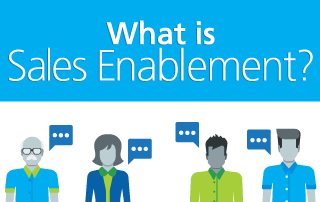sales-enablement
7 Predictions for What 2017 Holds for Sales Enablement
Whether your company’s sales struggled or excelled in 2016, there’s no denying that the year saw a great deal of innovation in how businesses approach the sales process. This coming year will be no different. While nobody knows for certain what the future holds, some B2B sales trends have been building up for some time now—can you guess what they are? Here are our top predictions for where 2017 will take sales enablement.
1. Content delivery and recommendations will still remain a key factor in buyer decisions
Are sales presentations a thing of the past? One day they might be, but today (and all of 2017 for that matter) is not that day. Buyers faced with complex B2B purchasing tasks still appreciate tailored and relevant content. The pressure is on sales teams to supply that content, and sales enablement tools will continue to provide reps with an easy way to quickly find the right materials.
2. In mid-2017, a shift will begin to occur toward broader sales enablement goals
Currently, the sales enablement sphere is rather disjointed. While some businesses will seek sales enablement through sales training, others will consider themselves “sales enablers” simply because they’ve improved their content management process. However, this segregated approach will fade away in favor of “all in” sales enablement.
SEE ALSO: Tomato, Tomahto: How to Achieve “All In” Sales Enablement
These broader sales enablement goals will include:
- Better Assessment of Sales Team Needs
Instead of jumping to the first sales enablement solution that promises instant results, businesses will strategically assess where the weaknesses in their sales process lie before designing a solution.
- More Effective Tools Based on Assessed Needs
Using the data gathered from the needs assessment, businesses will be quick to pursue tools that are designed to meet those needs. Instead of generic sales enablement software, these tools will be geared toward solving specific problems.
- Better Hiring
Businesses will start recognizing that it’s far more effective to hire capable reps than to spend extensive time and resources on grooming less-than-ideal candidates. This focus on hiring will be about more than just pursuing experienced reps—it will include implementing more extensive vetting processes for new hires.
- More Precise Processes based on Role
By tracking sales and marketing activities, companies will be able to identify where individual team members are wasting time on tasks. This will lead to more clearly defined roles and processes to follow.
- More Targeted Training and Skill Development
Consider generic sales training like broad spectrum antibiotics on a sick patient—it’s better than nothing, but it can’t compete against a targeted treatment. Through analytics, businesses will be able to identify where each rep needs skill development and then automatically offer on-the-spot, tailored training.
3. Deeper analysis of sales activities and effective use of seller time
It’s still a common thing for sales departments to just go through the motions with daily activities, but sales analytics are changing that. By tracking every action that reps take throughout the sales process, companies will be able to identify which actions are time-wasters, which ones are overlooked, which ones lead to the highest close rates, etc. With this information, businesses will be able to optimize seller time.
4. Greater emphasis on effectiveness of activities
“Checklist” sales don’t cut it anymore. Spending two hours on a killer sales presentation is a waste of company resources if that presentation doesn’t result in a won deal. Businesses will start connecting actions to results by tracking buyer engagement—which emails received the most responses? Which videos were watched most frequently? Which presentations were shared with other members of the buying team? Quality, not quantity, will win the day.
5. Greater awareness and effectiveness of frontline coaching and management
Coaching works, yet for some reason, it hasn’t often been a priority for businesses in the past. A frontline approach to sales coaching consistently leads to better sales rep performance, but don’t just take our word for it. With the tracking and analytics tools that are now available, companies will start doing their own assessments to test if investing in more frontline coaching (and better coaching practices) leads to higher win rates. Spoiler alert: it will.
6. Greater awareness and analysis of messaging effectiveness delivered by sales reps
It’s not necessarily what you do, but how you do it that matters in B2B sales. Do your buyers prefer results-oriented language? A formal tone or a casual one? Clear and direct messaging or a “call for more information” approach? By testing different messaging methods and comparing the buyer responses this year, companies will be able to fine-tune the language that resonates most with their target audience.
7. A tighter connection between sales objectives and how to measure progress via sales activities
Too often, sales goals are set arbitrarily or based on a fraction of the available sales data. As more companies adopt tools for tracking sales activities, it will become much easier to set attainable and realistic sales objectives. These goals will not only benefit the sales team but also management, as analytics provide far more accuracy in predicting sales projections for coming quarters.








